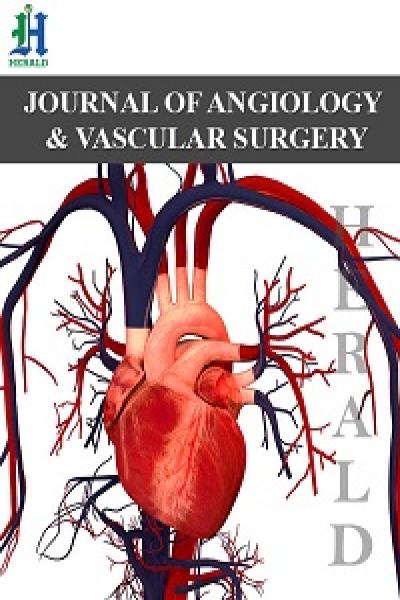
Ectopic Common Origin of Right Coronary and Left Circumflex Arteries from Ascending Aorta in Acute Coronary Syndrome
*Corresponding Author(s):
Katarzyna NawarskaDepartment Of Interventional Cardiology And Cardiac Arrhythmias, Medical University Of Lodz, Ul. Zeromskiego 113, 90-549 Lodz, Poland
Tel:+48 426393563,
Email:kasia.nawarska@wp.pl
# Equal Contribution
Keywords
Acute coronary syndrome; Coronary artery anomalies; Ectopic origin of coronary arteries; Percutaneous coronary intervention
Introduction
Coronary artery anomalies are found in 0.6% to 1.55% of patients [1]. Most cases remain asymptomatic, are detected during elective coronary angiography, and are hemodynamically insignificant [2]. Anomalies can be classified based on the coronary arteries' origin, course, or termination [2,3]. Recognition of these anomalies is crucial for treatment, especially in patients with Acute Coronary Syndrome (ACS).
Case Presentation
A 68-year-old female patient with a history of nicotinism for 20 years, previously untreated for cardiac reasons, was referred to our department as an emergency patient due to ACS without ST-segment elevation. On admission, the patient reported typical exercise-induced angina over the past five days, with resting discomfort on the day of presentation. Resting electrocardiogram showed normal sinus rhythm at a rate of 86 bpm, with a 1-mm horizontal ST-segment depression in the inferior leads (II, III, aVF) (Supplementary Figure S1). In laboratory studies, attention was drawn to slightly elevated high-sensitive cardiac troponin T concentrations: 26 ng/L (normal ectopic origin of the right coronary artery (RCA) and the left circumflex artery (LCx) directly from the aorta above the right coronary sinus, with critical stenosis in the first segment of the RCA (Figure 1A-C). An independent origin of the left anterior descending artery was visualized in the left coronary sinus, demonstrating non-significant atherosclerotic lesions (Figure 1D). Following initial RCA pre-dilation with semi-compliant and non-compliant balloons, the drug-eluting stent was implanted, resulting in successful dilatation of the lesion and Thrombolysis in Myocardial Infraction (TIMI) grade 3 flow (Figure 1E-F). Throughout the hospitalization, the patient did not experience any recurrence of angina.

Figure 1: Invasive coronary angiography and percutaneous coronary intervention. A. Non-selective contrast injection into the right coronary sinus, the ostium of the right coronary artery was not visualized. B. Overlay of the two angiography images: nonselective contrast injection and one focused on the ostium (indicated by the arrow). C. The common origin of the right coronary artery and the left circumflex artery is directly from the aorta above the right coronary sinus; long, critical stenosis is present in the first segment of the right coronary artery. D. Independent origin of the left anterior descending coronary artery from the left coronary sinus; artery without significant atherosclerotic changes. E. Implantation of the drug-eluting stent. F. Coronary angiogram after angioplasty- complete dilatation of the lesion and TIMI grade 3 flow. Abbreviations: RCA, right coronary artery; LAD, left anterior descending artery; LCx, left circumflex artery; RCS, right coronary sinus; LCS, left coronary sinus; NCS, non-coronary sinus (Supplementary Figure 1).
Discussion
Anomalies of the origin of coronary arteries are classified as benign and malignant [2-4]. Benign anomalies are generally asymptomatic, while malignant ones may potentially lead to myocardial ischemia, supraventricular and ventricular arrhythmias, myocardial infarction, or sudden death [2-4]. The ectopic origin of the RCA directly from the ascending aorta is an extremely rare anomaly, affecting just 0,006% of patients [5]. A common origin of RCA and LCx directly from the ascending aorta is a casuistic case, and to the authors' knowledge, has not been previously reported in patients with ACS without ST-segment elevation. If visualizing the coronary artery origins is difficult in patients with chronic coronary syndrome undergoing elective coronary angiography, invasive diagnostics may be postponed in favor of cardiac computed tomography angiography. However, this is not possible in patients with ACS, as in the described case, in whom a simultaneous, urgent percutaneous coronary angioplasty procedure is necessary. Such a procedure is challenging for the invasive cardiologist; it requires multiple diagnostic catheters, and the percutaneous coronary intervention is fraught with more significant technical difficulties.
Conclusion
Proper recognition of an anomaly such as the ectopic origin of RCA and LCx directly from the ascending aorta is of greatest importance, especially in acute clinical settings when other imaging modalities are inaccessible.
Conflicts Of Interest Statement
The authors declare that there is no conflict of interest regarding the publication of this paper
 Supplementary Figure 1: 12-lead resting electrocardiogram, normal sinus rhythm at a rate of 86 bpm, with a 1-mm horizontal ST-segment depression in the inferior leads (II, III, aVF).
Supplementary Figure 1: 12-lead resting electrocardiogram, normal sinus rhythm at a rate of 86 bpm, with a 1-mm horizontal ST-segment depression in the inferior leads (II, III, aVF).
References
- Plastiras SC, Kampessi OS, Gotzamanidou M, Kastanis P (2008) Anomalous origin of the left circumflex artery from the right coronary artery: a case report. Cases J 1: 336.
- Gentile F, Castiglione V, De Catrina R (2021) Coronary artery anomalies. Circulation 144: 983-996.
- Yamanaka O, Hobbs RE (1990) Coronary artery anomalies in 126,595 patients undergoing coronary arteriography. Cathet Cardiovasc Diagn 21: 28-40.
- Yuan SM (2014) Anomalous origin of coronary artery: taxonomy and clinical implication. Rev Bras Cir Cardiovasc 29: 622-629.
- Yuksel S, Meric M, Soylu K, Gulel O, Zengin H, et al. (2013) The primary anomalies of coronary artery origin and course: a coronary angiographic analysis of 16,573 patients. Exp Clin Cardiol 18: 121-123.
Citation: Nawarska K, Wcislo T, Ksiazczyk M, Warchol I, Plewka M (2024) Ectopic Common Origin of Right Coronary and Left Circumflex Arteries from Ascending Aorta in Acute Coronary Syndrome. J Angiol Vasc Surg 9: 122.
Copyright: © 2024 Katarzyna Nawarska, et al. This is an open-access article distributed under the terms of the Creative Commons Attribution License, which permits unrestricted use, distribution, and reproduction in any medium, provided the original author and source are credited.

